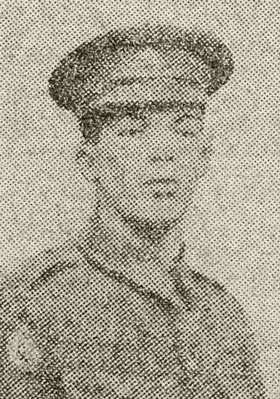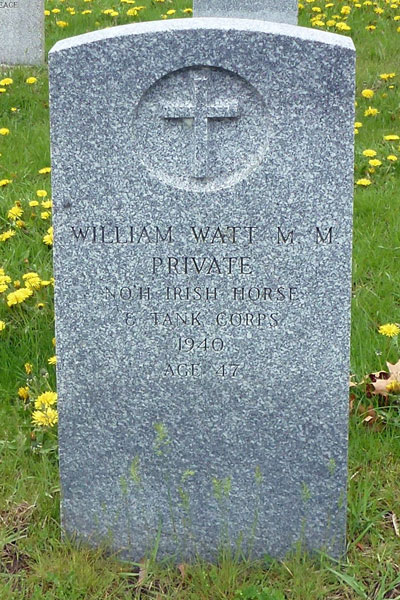Corporal William Watt, MM
William Watt was born on 1 February 1893 at Brickland, Rathfriland, County Down, the seventh of eight children of farm labourer David Watt and his wife Essie Jane (née Pollock). His mother died when he was just 7 years old. At the time of the 1901 Census he was living at Ballinaskeagh, Glaskermore, County Down, with his father and five of his siblings.
Watt enlisted in the North Irish Horse on 13 August 1914 (No.1001 – later Corps of Hussars No.71193). He embarked for France on 1 May 1915 with D Squadron, which at the time was serving as divisional cavalry to the 51st Division.
In May 1916 D Squadron came together with A and E Squadrons to form the 1st North Irish Horse Regiment, serving as corps cavalry to VII, XIX, then V Corps.
In November 1917 Watt was awarded a Military Medal. He was the first North Irish Horseman to win that medal while serving with the regiment.
On 7 January 1918 he was one of thirteen men from the 1st North Irish Horse Regiment who transferred to the Tank Corps. He was issued a new regimental number – 305509. After training at the Tank Corps Depot at Bovington, Devon, he embarked for France, where he was posted to the 12th Battalion. He was wounded during the Advance to Victory offensive, either on 21 or 23 August at the Battle of Albert, or at Drocourt-Queant on 2 or 3 September.
Watt was demobilised and transferred to Class Z, Army Reserve (or discharged – the records are not clear) on 16 February 1919. He unsuccessfully applied for a wound pension, it being assessed that he had no disability.
After the war he lived in Belfast, at 15 Prospect Street, then at 28 Clanchattan Street, Limestone Road, and worked as a shop assistant and a bar manager. On 26 February 1920 he married Sarah Nesbitt in the Malone Presbyterian Church. The couple emigrated to Canada, sailing from Liverpool on 8 December 1922. He died on 30 September 1940 and was buried in the Woodland Cemetery, Hamilton, Ontario.

William Watt (left) and his wife Sarah (seated), perhaps taken on their wedding day. The other man is his brother Robert
Two of Watt's brothers also served in the war – John in the Royal Irish Rifles and James as a driver in the Mechanical Transport section of the Army Service Corps. James was accidentally killed in Belgium on 26 July 1917, while attached to XVIII Corps Heavy Artillery, when run over by a motor lorry. He left a widow, Marion, and a child, Mary Elizabeth. He was buried in the Mendinghem Military Cemetery.
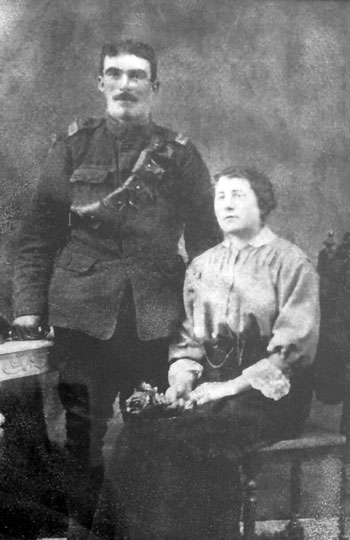
John Watt

James Watt
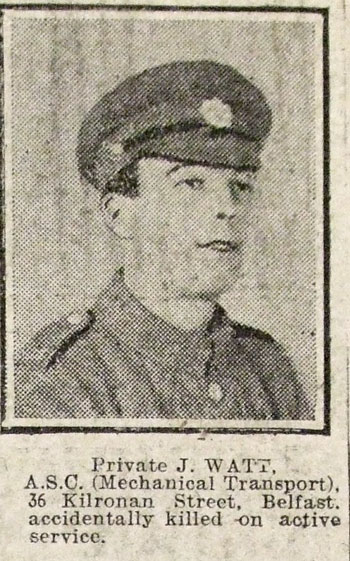
James Watt
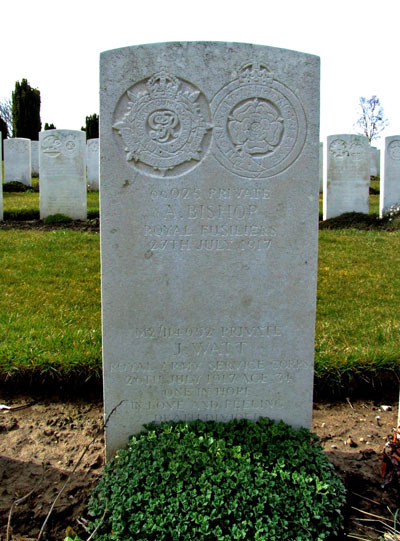
James Watt, Mendinghem Cemetery
First and last images, from The Belfast Evening Telegraph, kindly provided by Nigel Henderson, Researcher at History Hub Ulster. Wedding image of Watt sourced from Ancestry.com Public Member Trees - contributor Sarah Borg. Image of William Watt's grave sourced from the Find-a-Grave website. Image of John Watt and first image of James Watt sourced from Ancestry.com Public Member Trees – contributor Sarah Borg. Image of James Watt's burial place kindly provided by Mick McCann from the British War Graves site.
This page last updated 5 November 2023.

